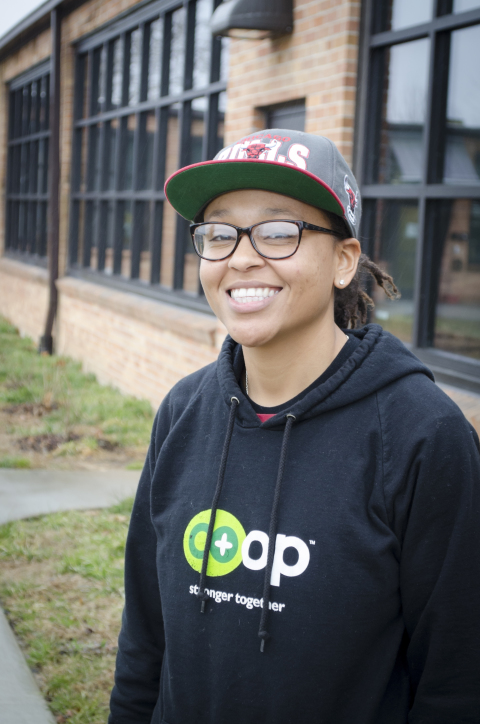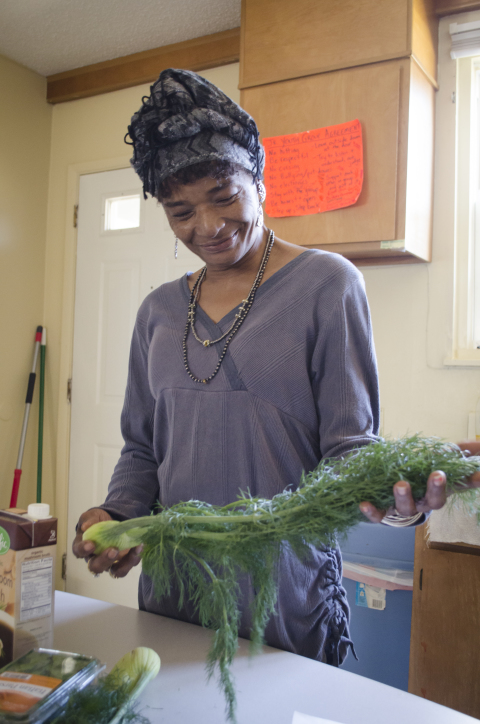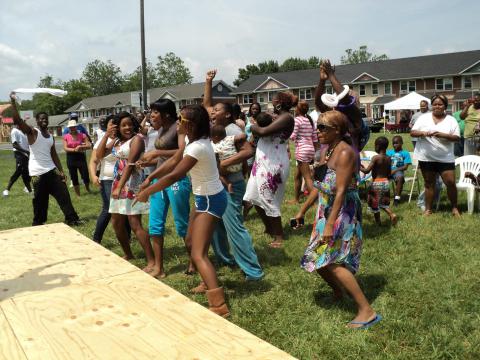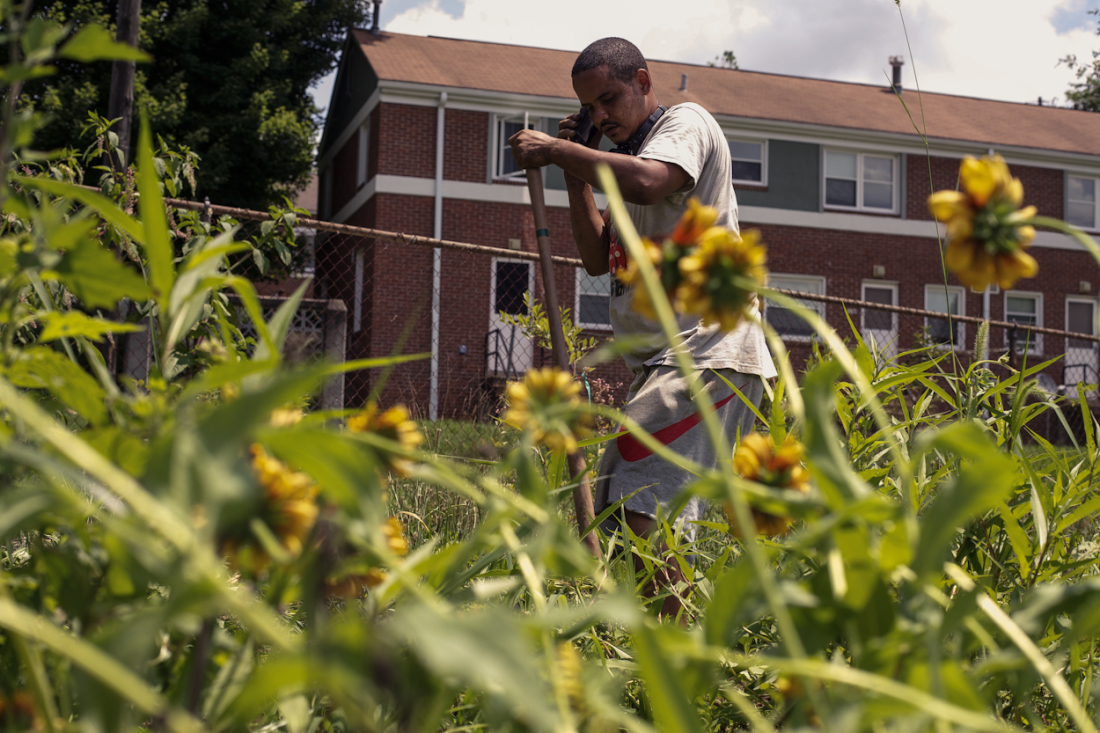For a long time, the far corner lot in Pisgah View Apartments was nothing more than an abandoned baseball field where weeds grew taller than many of the neighborhood’s children. The space was filled with trash, empty bottles and tough red clay — and couldn’t be more different from what’s there now. Today that same lot is home to rich brown soil, tidy rows of vegetables and flowers, a greenhouse, a cob oven and even a few fig trees.
In the growing season, the Pisgah View Community Peace Garden, as the former baseball field is now called, is a gathering spot for community get-togethers where neighbors plant zinnias and cook sweet potato pies in the sunshine. Year-round, the garden serves as a source of agriculture-based employment for Pisgah View residents, including Sir Charles Gardner and Carl Johnson Jr., who sell the garden’s yield at farmers markets and to local restaurants.
The garden is a spot for nutrition lessons and cooking demonstrations and for neighbors to gather together to harvest fresh produce — and it may not be the image that comes to mind for many when they think of public housing in Asheville.
More than 3,000 people live in the developments owned by the Housing Authority of the City of Asheville. These communities are mostly located in the city’s far corners or isolated neighborhoods, out of sight for many Asheville denizens. The result is a geographic and social isolation that has led to an idea of these neighborhoods as places of violence and filth where the sustainability practices championed in the rest of the city go ignored.
But residents of public housing, and the agencies that aid their efforts, say that perception simply isn’t true. These communities are home to environmental stewardship, they say, as well as eco-friendly youth-education programs, green jobs and an invested interest in their residents’ welfare that is only growing.
Getting started early

HACA estimates that 1,313 children ages 17 and younger live in Asheville’s public housing sites as of December 2014. Because low-income communities often face barriers that limit access to green space — both physically and socially — that’s a sizable population of potential environmentalists who may never have the chance to truly appreciate the outdoors.
“A lot of kids aren’t interested in science — not just environmental science, but all science,” notes Dewana Little, community engagement coordinator at Asheville GreenWorks. “They might hear about the importance of the environment in their biology classes, but with everything else going on in their lives, they might not absorb that.”
To encourage environmental education, GreenWorks began offering a paid internship program open to youths ages 16 to 19 who live in public housing neighborhoods. The interns’ job is to collect information on water quality in streams near the developments, determine how the streams are linked to conditions in the neighborhoods and create activities to teach younger children about the importance of their findings.
“When we get them out in the creeks, they’re able to make those connections and see why this is important and how what happens in their communities affects the whole environment,” Little says. “A lot of the kids haven’t had the opportunity to have that kind of hands-on experience. They don’t know if they care about something until you give them the opportunity to be a part of it.”
Eric Bradford, GreenWorks’ volunteer coordinator, adds that having the older kids teach the younger kids is also a powerful tool. “When I come into that neighborhood, I’m just this super-old guy talking about the environment, and it’s lip service,” he says. “But these guys grew up in that neighborhood, and the younger kids know them. And, of course, they’re cool because they’re 16 to 19 years old.”
Little, who also serves as vice president of the Erskine-Walton Apartments Residents’ Council, says the interns’ efforts are inspiring plenty of adults too. “You’re starting to hear people say, ‘Y’all come pick up this trash,’ or ‘Don’t throw that trash down in my yard.'”
As part of the program, GreenWorks also organized community cookouts where the interns led trash pickups and environmentally themed games in late summer 2014. “After our cleanup last August in Livingston and Erskine-Walton, we went back through there in November to see if the cleanup was sustained,” Little says. “It was still clean. It caught on. Kids come up to me now with bags of recycling.”
But GreenWorks’ program isn’t just about cleaning up the streams and getting the trash off the ground. Bradford says the real goal of the 100-hour internship is career building — encouraging teens from low-income communities to engage in college-level work and consider careers in urban conservation.
“We’re looking to plant the seed of an idea that says, ‘This is an option. When you go into the workforce, you can consider this type of work,'” Bradford says. “These job opportunities exist, and you can do them right here in Asheville. You can do this kind of work a mile from your house.”
The green kids on the block

Asheville’s Southside neighborhood was once a bustling black business district, though much of this changed with the urban renewal projects of the 1950s and ’70s. Today that neighborhood, sandwiched between the growing economic areas around A-B Tech, the River Arts District and Mission Hospital, houses several public housing communities, including Lee Walker Heights, Bartlett Arms and Livingston and Erskine-Walton apartments.
When you look around this neighborhood now, a lot of what you see is isolation — both racial and economic, notes Billy Schweig, mission advancement director at Green Opportunities. GO, which launched in 2009, is a job-training program that operates out of the Arthur R. Edington Education and Career Center, formerly known as the W.C. Reid Center, a LEED-certified building located right by Livingston and Erskine-Walton apartments with historic significance to the Southside community.
“All that development that’s happening — we’re smack in the middle of it,” Schweig says. “And yet, there’s a ridiculously high unemployment and poverty rate surrounded by all this money filtering in and out.”
GO seeks to place residents of low-income communities into “green collar” jobs. The organization’s job training programs, including its two main programs, Built Environment and Kitchen Ready, cover eco-centric fields such as green construction, landscaping, culinary arts, building science, urban agriculture and weatherization.
Schweig notes that the programs are designed to get GO students to take sustainability concepts and apply them to the private sector. In the last six years, GO has placed 205 trainees in jobs that averaged $10.30 an hour, and in 2014, 47 of its 56 graduates went on to permanent jobs or paid apprenticeships.
“We consider almost any job to be a ‘green job’ as long as it’s benefiting environmental or economic health in low-income communities,” Schweig notes. “We define sustainability really broadly because environmental sustainability is pretty much meaningless without social and economic sustainability.”
The organization itself has also been a source of full-time employment for current and former public housing residents, including Anna-Marie Smith, GO’s recruitment and support coordinator — though Smith says when she first heard of the job training programs, she “didn’t fall for it.”

“I was young, I was working in retail, making a little bit of money,” Smith recalls. “When they pitched it to me, I was like, ‘No thanks.'” But Smith says she came back looking for a way to branch out from the “stereotypical, female-oriented” jobs that retail offered and find something more interesting than selling shoes. She excelled in the training and was well-liked by her peers, serving as “a bridge” between her classmates and the instructors.
After graduation, GO offered Smith a chance to stay on full time in a capacity she had already proved herself in — being the go-to person for other students. On a day-to-day basis, Smith coordinates GO’s efforts to support trainees beyond the classroom by helping them with issues that come up in their lives — other jobs, transportation, funding for school, a need for legal representation, access to food — so they can concentrate on the program.
For Smith, who grew up in and out of Asheville’s public housing, it’s a way to take her experience and use it to inform others. “I always let them know that you can trust me because I’ve been here all my life and I can tell you the ins and outs,” Smith says. “From the people with the most advantages to the people with the least advantages in this city, I can help you get to where you want to be, if you really want to go.”
And Smith says that’s what the program really offers — a fair chance to move your life forward. For Smith, her job gave her the stability to transition out of public housing and the inspiration to go to college to study human resources and someday “run the whole show” at Green Opportunities.
“It’s really all through the grace of GO,” Smith says. “We all are here because of the same thing. We’re just trying to advance ourselves. This is the fair shot that everybody deserves.”
Welcome to the neighborhood

If you never thought to connect community gardens and green jobs with public housing, you might not be alone. For many people in Asheville, public housing conjures up images of gunshots, drug deals and trash, says Nicole Hinebaugh, program director at the Women’s Wellbeing and Development Foundation.
“I think when people come into public housing they have this belief ahead of time about how it’s going to be,” Hinebaugh says. “But if you come into a place like Hillcrest, you see sweet grannies rocking on their front porches and kids playing in the trees or in the basketball games. People are often surprised.”
For Hinebaugh and WWDF, part of supporting sustainability is addressing general welfare, which means overcoming the feelings of isolation and neglect that have seeped into Asheville’s public housing communities.
“Their voices aren’t heard,” Hinebaugh says of public housing residents. “People aren’t paying attention to what’s going on for them and aren’t consulting with them about decisions that affect them. It’s allowed to continue because the public either doesn’t know or doesn’t care.”
Hinebaugh says many in Asheville never visit public housing neighborhoods or know anyone who lives there. It’s a separation that has had a reciprocal effect as well, she says — creating resident mistrust toward nonprofits and other outside groups that have started — and in many cases abandoned — numerous public welfare projects in the public housing communities.
“After that happens enough times, there’s a real wariness that develops toward people that come in from the outside,” Hinebaugh says. “There’s an attitude of, ‘Well, when are they going to leave? Because everybody eventually leaves.'”
To address that barrier, WWDF started the Hillcrest Resource Center. The center provides a space for outside organizations and services such as MANNA FoodBank, OnTrack WNC, Mountain Housing Opportunities, Just Economics and Pisgah Legal Services to offer programs on leadership, tenants rights, how to sign up for food stamps or how to fill out tax returns.
“The resource center has been there for three years, [WWDF] has been [in Hillcrest] for over four years,” Hinebaugh says. “People know us, and they trust us. So they don’t already have to have a relationship with OnTrack to access the services OnTrack is providing because it’s coming through a trusted source.”
The resource center is also a space for cooking, crafting, yoga, youth empowerment, and herbs and wellness classes, most of which are led by residents. The programs are creating social networks, providing kids with more activities and, most importantly, Hinebaugh says, allowing for choices. “The fact that I know I can go to yoga if I want to makes me feel better about my community, even if I’m not accessing it,” she says. “That’s true in other communities in Asheville, and it’s true in public housing.”
Another part of WWDF’s mission is to bring the public into public housing. The organization helped to launch Juneteenth, a community celebration in Hillcrest that honors the end of slavery in the United States with games, food, live music and entertainment — to which the greater Asheville community is invited.
“Once the public realizes these are families whose quality of life, work and dignity matters, whose access to basic needs matters, that the way they’re being treated by their landlord, it matters,” Hinebaugh says. “Once more of the public becomes aware, we’ll begin to see pressure put on these issues that will help the residents move out of marginalization.”
A greener future

Green initiatives in Asheville’s public housing are coming off of many advancements in 2014, with more efforts planned for the coming year.
GreenWorks is working on planting fruit orchards in at least two of the developments as a potential source of community revenue, with hopes of partnering with Ujamaa Freedom Market in the Hillcrest community. But an even bigger issue for the organization is bringing recycling to all public housing communities. The city of Asheville currently does not provide recycling services to large apartment complexes, and though private companies collect recyclables in six of the nine public housing developments, the service is not currently offered in Pisgah View, Deaverview or Klondyke.
“It’s not a good look when you drive through Asheville and you see, on this side of the street is the blue recycling bins, and on this side of the street there is nothing,” Little says. “It tells you, ‘Ah, here is where the underserved community is.’ And if you live in that neighborhood, it feels like, ‘Why can’t we have recycling? What makes us different?'” GreenWorks is working on a long-term proposal to gather recyclables and use the sale of the raw materials to fund more community activities.
WWDF is focusing on the national conversion of public housing funding to Rental Assistance Demonstration, which will utilize a Section 8 platform. Hinebaugh says, in the long term, RAD may allow for a switch to cooperative housing, where residents may purchase their own housing unit. The organization hopes to work with HACA to launch a pilot cooperative housing program in Asheville.
With the first phase of renovation completed at the Edington Center, GO can focus on its new community garden that harvests collected rain water to grow food for its industrial kitchen. The kitchen then allows GO students, with the occasional help of guest chefs from Asheville restaurants such as The Admiral, Chestnut and Rhubarb, to offer free lunches to the community four days a week. The meals are open to anyone and donations are accepted for the program.
But GO’s garden doesn’t stop there. Any excess yield will go to a planned community grocery store within the Edington Center — bringing fresh produce to the Southside food desert where residents would otherwise trek long distances to purchase food at supermarkets or settle for buying their groceries at a gas station. “We want this to be a space for the community to network and learn from each other,” Schweig says of the organization’s remodeled space. “We want this to serve as a model for how not to gentrify a neighborhood.”




The final responsibility for improving things within any public housing authority lays with their head person. In Asheville, that is Gene Bell, and his side-kick, David Nash. Other than passing the buck to the many well-intended under-funded nonprofits mentioned here, what exactly are these 2 guys doing with their budget and their own respources to fix problems? The article pretends like these 2 guys do not exist, have no responsibilities, and does not mention any of Gene or David’s staff as helping to address any of the issues highlighted.
This is an important observation because at the end of the day, the housing authority has to be held accountable and only they can be held accountable. I applaud the residents sweating it out in the garden program, and the residents sweating it out in the kitchen program, but we have no idea how effective these programs are. We know GO has a budget of a million dollars and only graduates about 4 groups of trained people a year, of about 15 each. But rather than blame them, maybe the waste and lack of better results is because the housing authority is not doing more, not being more effecient, not being more effective, in getting more results from the money spent.
And no one is demanding that they get more results with their own respources. Not Mountain Xpress, not the ACT, not City Council. Maybe not even the residents? How did this ever come to be?
Reading this article makes it seems like there’s no problems at all in public housing, yet there is, and we will be reminded the next time a “crisis” occurs. Will the newspapers focus on the people reacting to the crisis and called onto scene such as firemen, paramedics or police? Or will it focus on the people who are responsible for running public housing? Agaim it’s nice that outside groups are trying to help but they really can’t be held accountable for results or lack of results, not in the way that Gene Bell and David Nash can be held accountable. Do any of the Mountain Xpress reporters even know who Gene Bell and David Nash are? And here’s a really tough question: do they know who Gene and David’s bosses are? If so, when are these people going to be interviewed, and their faces shown and names printed, and quizzed on how they themselves, rather than under funded outsiders, are held accountable for getting better results such as more job placements, recycling, and safety? I mean, christ, Gene and David and their bosses are not even held accountable for getting in a recycling system? Really? Gene gets paid over $100,000 a year, What are they accountable for?(hint, their bosses are called a board of commissioners and 100% of them are appointed by the Mayor. Does Mayor Mannheim hold them accountable for anything besides passing the buck?)
How did I miss this article and your great response a year ago ? found it while researching ‘Go Green Asheville’ and all of that…
No, Nathan….the AVL housing authority (HACA) is nothing BUT a federal government money pit run by high salaried dudes who
cannot manage nor control their ‘business’ , the biggest bloated blight on the city of Asheville! Our criminal city council and Maoyor offer NO oversight of HACA by choice. Last year Gene Bells salary was in excess of $125,000, David Nash $90K+ …
In June 2015 former mayor Terry Bellamy was hired by HACA as a ‘co-ordinator’ at $53,000 starting…within 6 months she was
elevated to a newly created position of ‘Communications Director’ with a FAT salary increase which David Nash fails to report.
HACA in this town is a sketchy sketchy operation…tightly controlled. Remember, segregated housing is run totally by democrackkks, the racist party of slavery.